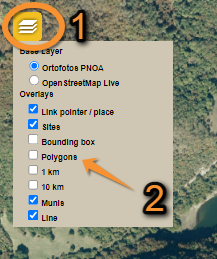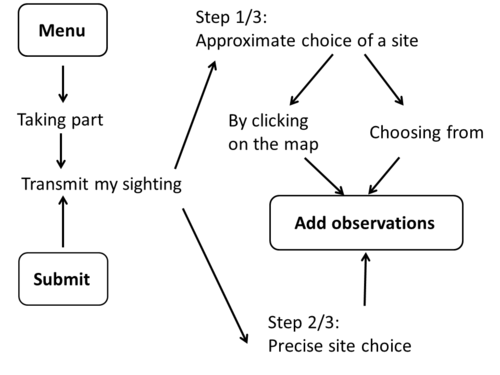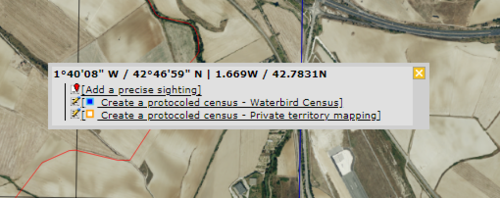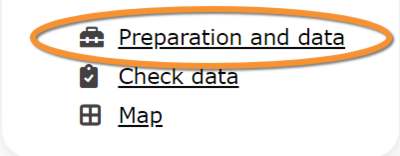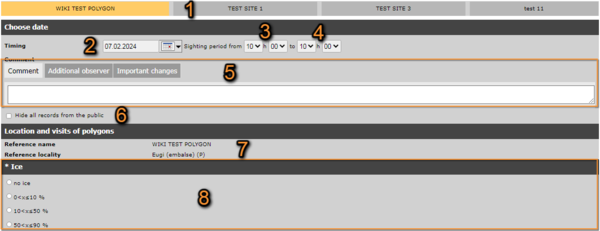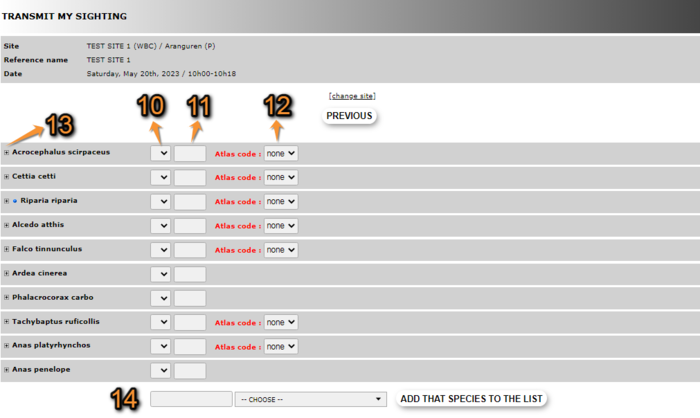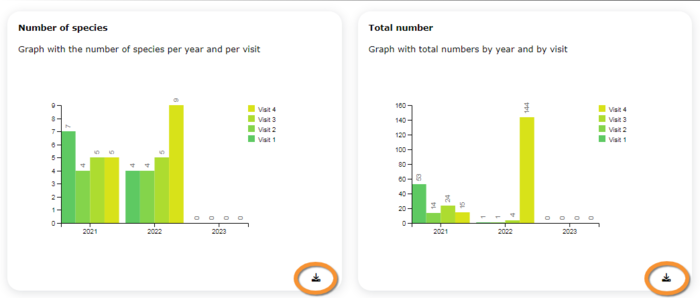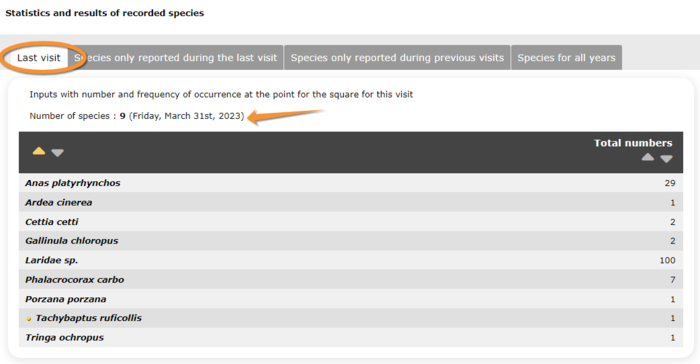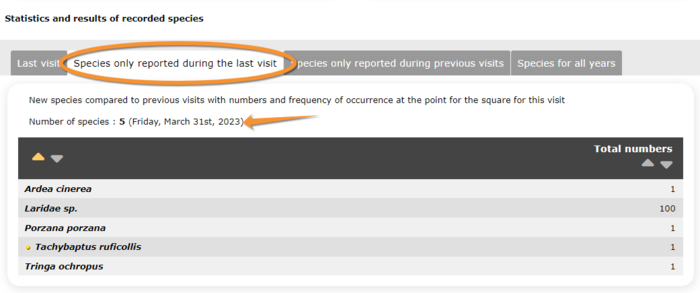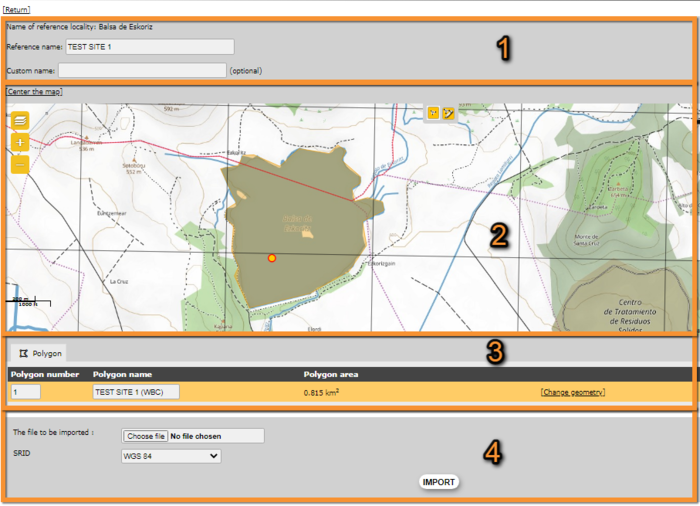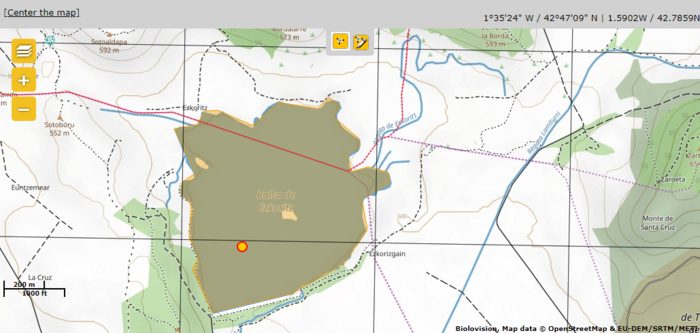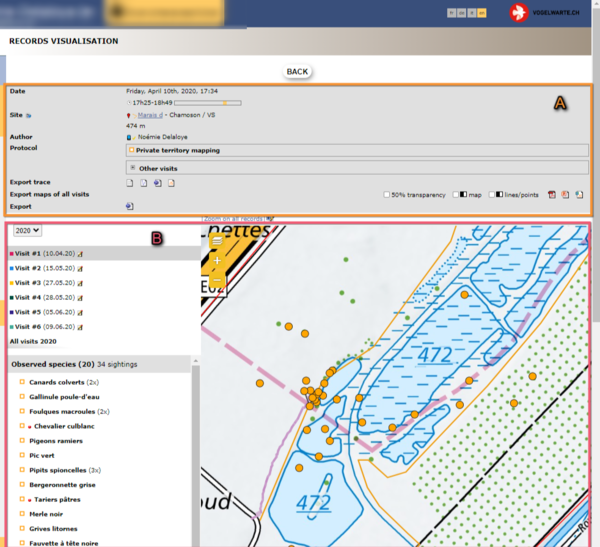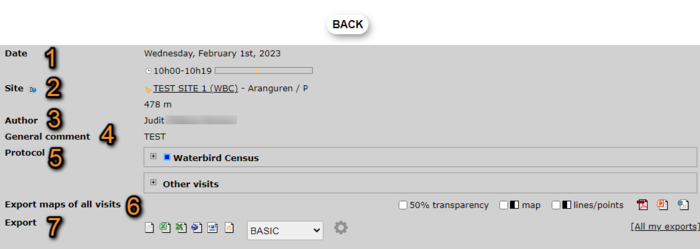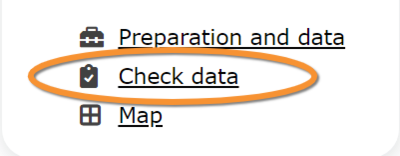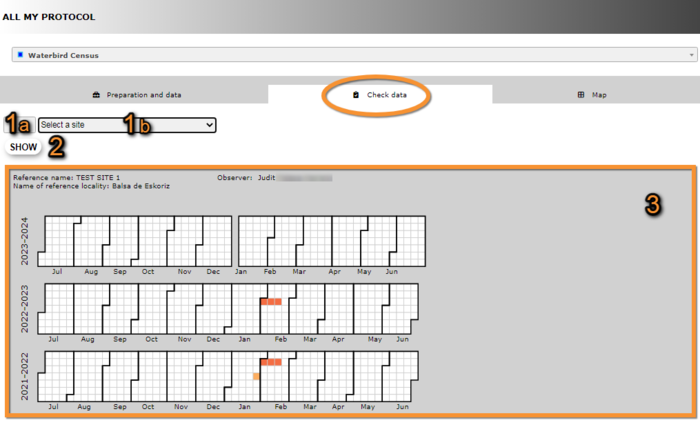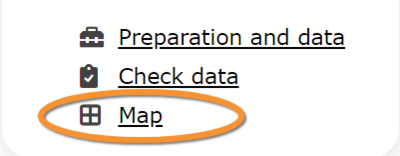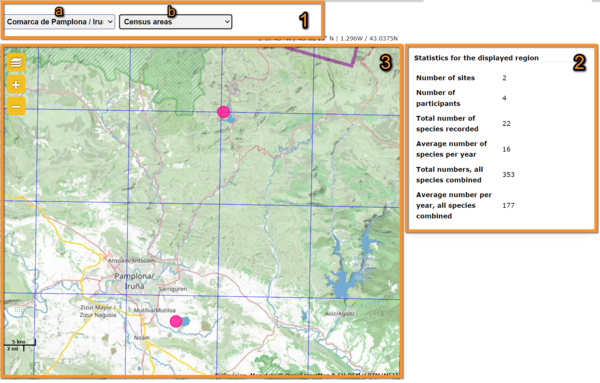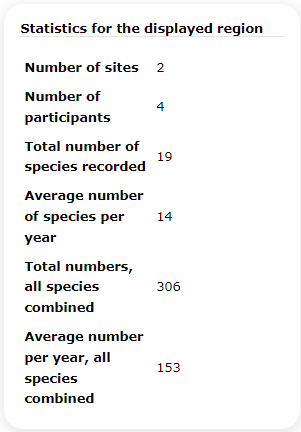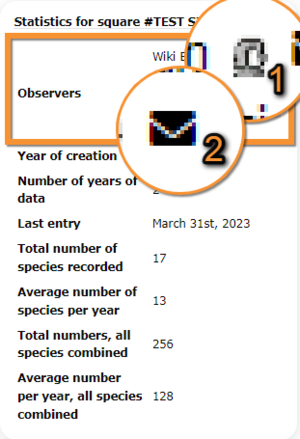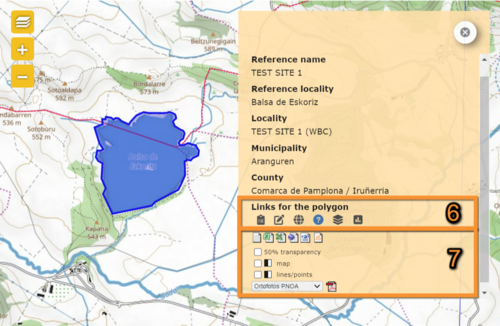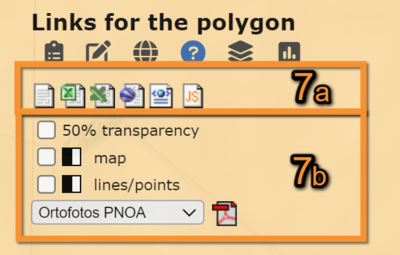Protocolos
Los protocolos son formas estandarizadas de tomar datos asociadas a una geometría (puntos, transectos, polígonos), a un grupo taxonómico y a una presión de observación.
La metodología a seguir depende los objetivos del estudio (consulta la tabla más abajo).
Un administrador local te permitirá el acceso si se cumplen ciertos criterios.
No todos los protocolos están disponibles en todos los países.
| Protocolos. Table resumen. | ||||||||||
|---|---|---|---|---|---|---|---|---|---|---|
| Nombre | Grupo | Página web |
NaturaList Android |
Puntos | Transectos | Polígonos | Censos/Años | |||
| Número | Tiempo/punto | Número | Tiempo/transecto | Número | Tiempo/polígono | |||||
| Censo de aves acuáticas | Aves | SÍ | SÍ | 1 | n/a | n/a | ||||
| Mapeo de territorios | Aves | NO | SÍ | |||||||
| Punto de censo | Aves | SÍ | SÍ | 1 | ||||||
| Pícidos | Aves | SÍ | SÍ | 5 | ||||||
| Protocolo de Lagópodo alpino | Aves | SÍ | SÍ | 1 | n/a | 1 | ≥ 1h | 2 | ||
| Protocolo de gallo lira | Aves | SÍ | SÍ | 1 | ≥ 1h | n/a | ||||
| Muestreo de Becada | Aves | SÍ | SÍ | 1 | n/a | |||||
| SOCC | Aves | SÍ | NO | 1 | 4 | |||||
| Rook | Birds | YES | YES | 1 | n/a | n/a | ||||
| Avión zapador | Aves | SÍ | SÍ | 1 | n/a | n/a | ||||
| Guión de Codornices | Aves | SÍ | SÍ | |||||||
| Grajilla | Aves | SÍ | SÍ | 1 | n/a | n/a | ||||
| Perdiz pardilla | Aves | SÍ | SÍ | 1 | n/a | n/a | ||||
| MHB & BDM | Aves | SÍ | SÍ | 1 | n/a | n/a | ||||
| MF | Aves | SÍ | SÍ | 1 | n/a | n/a | ||||
| VBS/DDPS | Aves | SÍ | SÍ | 1 | n/a | n/a | ||||
| Seguimiento de aves reproductoras en áreas protegidas | Aves | SÍ | SÍ | |||||||
| Mapeo de territorios | Aves | NO | SÍ | 1 | n/a | n/a | ||||
| Territorio de Pícido | Aves | SÍ | SÍ | |||||||
| Escribano cerillo | Aves | SÍ | SÍ | varios | n/a | n/a | ||||
| Cisne chico | Aves | SÍ | SÍ | 1 | n/a | n/a | ||||
| Rapaces | Aves | SÍ | SÍ | 1 | n/a | n/a | ||||
| Abejaruco europeo | Aves | SÍ | SÍ | 1 | n/a | n/a | ||||
| CoBiMo | Aves | SÍ | SÍ | <1 | n/a | n/a | ||||
Contents
-
1 Accesso a los protocolos
2 Preparación y datos
- 2.1 Añadir las observaciones
- 2.1.1 Iniciar del protocolo
2.1.2 Entrar observaciones
2.1.3 Terminar el protocolo
-
2.2 Resultados
-
2.3 Mostrar en el mapa
2.4 Cambiar el protocolo
2.5 Resultado de los censos
- 2.5.1 Sección del protocolo
2.5.2 Sección de las observaciones
2.5.3 Sección del mapa
Protocolos
-
5 Censo de aves acuáticas
6 Mapeo de territorios
7 Punto de censo
8 Pícidos
9 Protocolo de Lagópodo alpino
10 Protocolo de Gallo lira
11 Muestreo de Becada
12 SOCC
13 Graja
14 Avión zapador
15 Guión de Codornices
16 Grajilla
17 Perdiz pardilla
18 MHB & BDM
19 MF
20 VBS/DDPS
21 Seguimiento de aves reproductoras en áreas protegidas
22 Mapeo de territorios
23 Territorio de Pícido
24 Abejaruco europeo
Acceso a los protocolos
Accede a los protocolos desde
Menu > Participa > Todos mis protocolos para acceder fácilmente a todas las funciones para las que tienes permisos.
La forma más fácil de acceder a todas las funciones de un protocolo es a través del panel de protocolos. Ves a Menú > Participa > Todos mis protocolos. Se listarán todos los protocolos para los que tengas permiso en el portal local en el que estés (ver la imagen siguiente). Según tus permisos también podrás acceder al panel de protocolos a través de la sección Adminitración: Menú > Administración > Gestión de protocolos. Las opciones pueden variar en función de tus permisos (los administradores tienen acceso a más funciones).
Hay otras maneras de acceder, en ciertos casos, a algunas de las funciones de los protocolos (ver las secciones siguientes).
Introducir datos
Introduce observaciones a un protocolo a través del panel de protocolos (ver más arriba) o como si introdujeras datos.
Para introducir datos como si se enviaran observaciones,
1. accede a la página PASO 1/3 : Approximate choice of a site ya sea desde el menú principal o desde el botón Enviar.
2. Escoge entre:
- escoge desde
- Disponible solamente si ya has introducido datos en éste protocolo y lugar de estudio.
- Selecciona un protocolo, y un sitio de estudio (si tienes más de un sitio de estudio para éste protocolo).
- Disponible solamente si ya has introducido datos en éste protocolo y lugar de estudio.
- clicando en el mapa.
- clica en cualquier parte del polígono si quieres introducir datos en un protocolo que utiliza polígonos, o
- clica en el punto del protocolo si quieres introducir datos en un protocolo que utiliza puntos.
- clica en cualquier parte del polígono si quieres introducir datos en un protocolo que utiliza polígonos, o
NOTA: Muestra/Esconde polígonos clicando en la icona de capas en la esquina superior izquierda del mapa, y marca la casilla de polígonos (ver la imagen siguiente). Los polígonos se muestran en amarillo.
- Otras opciones (introduciendo el texto, escogiendo la municipalidad).
- Accede a Paso 2/3: Precise site choice. Baja hasta tu sitio de estudio.
- Accede a Paso 2/3: Precise site choice. Baja hasta tu sitio de estudio.
3. Selecciona Añadir observaciones en la nueva ventana (ver imagen siguiente).
Cambiar el protocolo
Modificar los protocolos desde
- el panel de protocolos. Ves a Menú > Participa > Todos mis protocolos > "Nombre del protocolo" > Preparación y datos > Modificar el protocolo. Consulta la sección wiki más arriba, Portal local > Protocolos > Acceder a protocolos.
- enviar observaciones.
- 1. Accede a la página PASO 1/3 : Approximate choice of a site desde el Menú principal > Participa, o desde el botón Enviar (ver imagen como ejemplo).
- 1. Accede a la página PASO 1/3 : Approximate choice of a site desde el Menú principal > Participa, o desde el botón Enviar (ver imagen como ejemplo).
- 2. Baja hasta escoger desde si has introducido datos previamente al lugar que quieres modificar; o clicando en el mapa para seleccionar un lugar en el mapa.
- 2. Baja hasta escoger desde si has introducido datos previamente al lugar que quieres modificar; o clicando en el mapa para seleccionar un lugar en el mapa.
- 3. Clica en el sitio a modificar y selecciona Modificación del protocolo del censo si accedes desde escoger desde; o Modificar el protocolo si accedes desde el mapa.
- 3. Clica en el sitio a modificar y selecciona Modificación del protocolo del censo si accedes desde escoger desde; o Modificar el protocolo si accedes desde el mapa.
- NOTA: Si el protocolo que quieres modificar funciona con polígonos, activa los polígonos desde el icono de capas en la esquina superior izquierda (ver imagen Mostrar polígonos en el mapa) antes de clicar en el sitio de estudio.
- NOTA: Si el protocolo que quieres modificar funciona con polígonos, activa los polígonos desde el icono de capas en la esquina superior izquierda (ver imagen Mostrar polígonos en el mapa) antes de clicar en el sitio de estudio.
Crear protocolo
Crea un sitio de estudio nuevo.
No todos los usuarios pueden acceder a esta función. Ésto depende del protocolo, el portal local y los permisos otrogados. Si puedes acceder, entra en el mapa como si enviaras observaciones y clica en cualquier parte del mapa (excepto en un punto o un polígono). Clica en Crear un protocoled census. SI tienes permisos para crear un sitio de estudio en más de un protocolo, se listarán todas las opciones (ver la imagen siguiente).
Introducir datos
- Menú > Participa > Todos mis protocolos > Preparación y datos > Añadir bservaciones.
- Menú > Administración > Gestión de protocolos > Gestión de protocolos.
- Página de inico > Enviar > Escoger desde > "Nombre del protocolo" > "Sitio de estudio" > Añadir observaciones.
- Página de inicio > Enviar > Clicando en el mapa > Añadir observaciones.
- Menú > Participa > Enviar observaciones > Escoger desde > "Nombre del protocolo" > "Sitio de estudio" > Añadir observaciones.
- Menú > Participa > Enviar observaciones > Clicando en el mapa > Añadir observaciones.
Modificar el protocolo
- Menú > Participa > Todos mis protocolos > Preparaci'on y datos > Modificar el protocolo.
- Página principal > Enviar > "Nombre del protocolo" > "Sitio de estudio" > Modificar a protocoled census .
- Página principal > Enviar > Clicando en el mapa > Modificar el protocolo.
- Menú > Participar > Enviar observaciones > Escoger dede > "Nombre del protocolo" > "Sitio de estudio" > Modification of a protocoled census.
- Menú > Participar > Enviar observaciones > Clicando en el mapa > Modificar el protocolo.
Crear un protocolo nuevo
- Página principal > Enviar > Clicando en el mapa > Create a protocoled census.
- Menú > Participa > Enviar observaciones > Clicando en el mapa > Create a protocoled census.
Preparación y datos
Clicar en Preparación y datos lista todos los sitios disponibles para el perfil actual y permite acceder a las funciones que se describen a continuación para cada uno de estos sitios:
Protocolo. Selección de sitio.
1. Cambia de protocolo clicando en el nombre del protocolo activo y seleccionando en el menú desplegable.
2. Mover a otras secciones del mismo protocolo seleccionando en las pestañas superiores.
3. Lista de todos los sitios a les que tienes acceso en el protocolo seleccionado (número 1). Cuando no tienes acceso a ningún sitio en el protocolo seleccionado, verás el mensaje a message "no count available".
2 Preparación y datos
-
2.1 Añadir observaciones
- 2.1.1 Empezar el protocolo
2.1.2 Introducir observaciones
2.1.3 Terminar el protocolo
-
2.2 Resultados
-
2.3 Mostrar en el mapa
2.4 Cambiar el protocolo
2.5 Resultado de los censos
- 2.5.1 Sección del protocolo
2.5.2 Sección de observaciones
Añadir observaciones
Clica en "Añadir observaciones" (ver imagen siguiente) en el sitio de estudio en el que necesitas introducir los datos.
Starting the protocol
Before entering observations, it is required to enter general parameters regarding the protocol.
1. Select site
If necessary, change site by selecting from the tabs. The active site is highlighted in yellow (see image above).
Choose date
- 2. Enter date
Choose from the expandable menu the date the survey took place.
- 3. Enter starting time
Enter the time the census started selecting from the expandable fields.
- 4. Ending time
Enter the time the census ended selecting from the expandable fields.
- 5. Enter comments
Choose one option from the tabs on top (5a) and type a comment (5b). Note the number of tabs and the information required may differ from country to country:
- Comment: if the comment will refer to a general observation,
- Additional observer: if you name other observer/s participating in the census,
- Important changes: to note important changes from your previous visit, like noise, pollution or construction work,
- Impacts: record any impact taking place during the survey,
- Incidents: report any incident that may have happened during the count.
- Comment: if the comment will refer to a general observation,
- 6. Hide all records from the public
Check if you do not want other users to see your records.
Location and visits
- 7. Count number
Some protocols have certain restrictions regarding the number or dates to conduct surveys. If the protocol requires it, select from the expandable menu which visit your data corresponds to. If the protocol does not require this field, you will only see Reference name and Reference locality.
8. Parameters
Enter parameters required for your polygon. Note fields and the order in which they appear may differ from country to country. You may not encounter all possible fields described underneath. Expand the table below to see all possibilities.
Fields marked with an asterisk are mandatory.
| Parameters | ||||||||||
|---|---|---|---|---|---|---|---|---|---|---|
| Name | Description | |||||||||
| Additional observer | Indicate if you are accompanied by someone whose observations are also recorded. | |||||||||
| Cloud cover | Indicate if there were clouds. | |||||||||
| Comment | You may enter a comment if you find it appropriate. | |||||||||
| Conditions in general | Choose how are surveying conditions overall regarding weather and disturbances, and may be asked to indicate on next section the reason if surveying conditions are not good. | |||||||||
| Conditions (notes) | Leave a note regarding conditions if necessary. | |||||||||
| Count method | Indicate if you are surveying from the ground, the air, the water, a different way, or if it is unknown. | |||||||||
| Count paid | Indicate if the count is paid for or not. | |||||||||
| Count type | Tick roost count if you are counting roosting birds, or during day otherwise. | |||||||||
| Counting mammals? | Indicate if besides the compulsory taxonomic group, you also counted mammals. | |||||||||
| Coverage | Indicate how much of the designated survey area is covered in the survey. | |||||||||
| Coverage (notes) | Leave any comment regarding the coverage. | |||||||||
| Drone used | Indicate if drones were used during the survey. | |||||||||
| Ice | Indicate the percentage of water surface that is frozen. | |||||||||
| Important changes | Indicate if there have been major changes since your last visit. | |||||||||
| Intact nests | Type number of intact nests. This information will be asked when entering data. |
|||||||||
| Moving/Harvest | Indicate the surface that has been harvested or mown. | |||||||||
| Neutralised time | Time to be removed from the official census time (like a pause) | |||||||||
| Nest location | Select from the expandable menu the location of the nest. | |||||||||
| Number of canoes/kayaks | Enter number. | |||||||||
| Number of fishing boats | Enter number. | |||||||||
| Number of fishing boats | Enter number. | |||||||||
| Number of motor boats | Enter number. | |||||||||
| Number of nests occupied by other species | Type number of nests occupied by species other than the ones counted in the current protocol. This information will be asked when entering data. |
|||||||||
| Number of persons on shore | Enter number. | |||||||||
| Number of rowing boats | Enter number. | |||||||||
| Number of sailing boats | Enter number. | |||||||||
| Number of sports divers | Enter number. | |||||||||
| Number of stand up paddlers | Enter number. | |||||||||
| Number of surfers | Enter number. | |||||||||
| Occupied nests | Type number of occupied nests. This information will be asked when entering data. |
|||||||||
| Optical equipment | Indicate which equipment you are using for the survey, if any. Note you can only choose one option. | |||||||||
| Playback | Check the species names for which playback will be played during the survey. | |||||||||
| Potential breeding pairs | Type the number of breeding pairs. This information will be asked when entering data. |
|||||||||
| Rain | Indicate if there was any rain. | |||||||||
| Reason(s) for moderate / bad conditions | If general conditions indicated above are not good, open the expandable menu and choose the reason (see image below). Only one option is possible: choose the one that is closest to the reality. | |||||||||
| Snow coverage | Indicate the proportion of snow cover. | |||||||||
| Sound played | Indicate if you used playback to detect the species by sliding the mark on/off. | |||||||||
| Suspected nests | Type number of suspected nests. This information will be asked when entering data. |
|||||||||
| Temperature | Indicate approximate temperature. | |||||||||
| Temporary shallow water bodies | Indicate the frequency of water bodies. | |||||||||
| Visibility | Indicate the approximate distance within which it is possible to identify species, or an overall description. | |||||||||
| Water level | Indicate the water level. | |||||||||
| Waves | Indicate how the waves are. | |||||||||
| Wind | Indicate if there was any wind. | |||||||||
9. Start entering data
Options may differ from protocol to protocol but can be summarised as:
- NEXT: Continue entering data normally.
- NEXT: Continue entering data normally.
- CHOOSE A LIST TO ENTER DATA: Some protocols make a distinction between a Basic and an Extended list (see image Continue to enter data as an example).
- CHOOSE A LIST TO ENTER DATA: Some protocols make a distinction between a Basic and an Extended list (see image Continue to enter data as an example).
- BASIC LIST: Select to load a pre configured species list strictly related to the protocol (ie. waterbirds). It will facilitate entering data. See an example of how it may look like in image Example of a basic list compared to an Example of extended list. Which species belong to a basic list is determined by each local portal and may differ from one to another.
- BASIC LIST: Select to load a pre configured species list strictly related to the protocol (ie. waterbirds). It will facilitate entering data. See an example of how it may look like in image Example of a basic list compared to an Example of extended list. Which species belong to a basic list is determined by each local portal and may differ from one to another.
- EXTENDED LIST: Select to load a pre configured species list strictly related to the protocol (ie. waterbirds) along with other related ones (ie. reed-living species). It will facilitate entering data. See an example of how it may look like in image Example of extended list. Species included in a basic list and an extended list are determined by each local portal and may differ from country to country.
- EXTENDED LIST: Select to load a pre configured species list strictly related to the protocol (ie. waterbirds) along with other related ones (ie. reed-living species). It will facilitate entering data. See an example of how it may look like in image Example of extended list. Species included in a basic list and an extended list are determined by each local portal and may differ from country to country.
- If the administrator of the protocol did not prepare any pre configured list for this protocol, you will not be given any list of species to enter from; but you will still have to choose a list option in this section.
- If the administrator of the protocol did not prepare any pre configured list for this protocol, you will not be given any list of species to enter from; but you will still have to choose a list option in this section.
- NO SPECIES / INDIVIDUALS WERE SEEN: Indicate if your survey did not provide any data. You will be taken to directly to end the protocol. Surveys with no species are also important results! It means you followed the established methodology, and therefore your survey is valid, but no birds were present. They can indicate major population changes and are of extreme importance for conservation purposes.
- NO SPECIES / INDIVIDUALS WERE SEEN: Indicate if your survey did not provide any data. You will be taken to directly to end the protocol. Surveys with no species are also important results! It means you followed the established methodology, and therefore your survey is valid, but no birds were present. They can indicate major population changes and are of extreme importance for conservation purposes.
|
Surveys with no species are also important results! Please submit them. It means you followed the established methodology but no birds were present. It can be due to methodology, disturbance, pollution or other major population changes and may be of extreme importance for conservation purposes. |
Entering observations
Enter observations as if entering a list. See wiki section Web interface > Submitting records > Step 3/3: Transmit my sighting > If accessed from a list> List section if further information is needed.
If your portal provided you with a basic or extended pre configured species list, use it to facilitate entering observations.
- 10. Count precision
- 10. Count precision
Choose from the expandable menu count precision. By default, no sign is displayed and the number entered is assumed to be accurate ( = precise number). See correspondence of symbols at Web interface > Codes and symbols.
- 11. Number of individuals
- 11. Number of individuals
Type number of individuals.
- 12. Atlas code
- 12. Atlas code
When available, select from the expandable menu the corresponding atlas code.
- 13. Additional information
- 13. Additional information
Click on the + sign to open the additional information form, and fill as described in wiki section Web interface > Take part: Submitting records > Step 3/3:Transmit my sighting > If accessed from a list (fill a daily form) > Additional information.
- 14. Other species
- 14. Other species
If you want to report a species not in the list, enter as usual: type the name of the species, or part of it, in the left hand field, select from the expandable menu on its right and click on add that species to the list to save the record. When in the list, indicate number of individuals, atlas code and additional information as previously described.
Ending the protocol
When all species are recorded, indicate
- 1. I recorded all species of the program if you identified and recorded all species seen or heard that are of interest to the protocol, or
- 2. I recorded all species (=full observation list) if besides all species of interest to the protocol, you also identified and recorded all other species seen or heard. Note you can only record in this list species identified within the designated study area. Any species recorded outside of the study area should be submitted as an individual record.
Then, you will be taken to set parameters to start a new protocol.
Results
See some general statistics about your surveys results on a page by graphs, list and list plus percent of frequency occurrence .
To see specific counts results go to Census results or Display on map.
Graphs Number of species and Total number :
Number of species
Represents the number of species recorded during each visit.
In the example in the image above, the user recorded 7 species during the first visit of 2021, 4 on the second visit, and 5 on each of the last two. Equally, no species were recorded in any of the 4 visits of 2023.
Click on the download icon (encircled in picture) to download the data as a .CVS file, that can be uploaded into R software.
Total number
Represents the number of individuals recorded in each visit, pulling all species together.
From the example in the image above, the user recorded 53 individuals on the first visit of 2021, 14 on the second and so on, and none in any of the visits in 2023.
Click on the download icon (encircled in picture) to download the data as a .CVS file, that can be uploaded into R software.
Statistics and results of recorded species:
- Last visit
List of species recorded at the selected site during the last visit. Use arrows under titles to alternate between ascending and descending order (see image as an example). Orange arrow in image indicates the date of last visit.
- Species only reported during the last visit
List of species recorded only during the last visit and no other visit. Use arrows under titles to alternate between ascending and descending order (see image as an example). Orange arrow in image indicates the date of the last visit.
- Species only reported during previous visits
List of species that were not reported during the last visit but were seen in one of the previous ones. Use arrows under titles to alternate between ascending and descending order (see image as an example). Orange arrow in image indicates the date of last visit.
- Species for all years
List of all species reported by the user at this site, and the frequency of occurence. Use arrows under titles to alternate between ascending and descending order (see image as an example). Orange arrow in image indicates the date of last visit.
Protocol. Results for all species.
Average frequence of occurrence: Proportion of visits in which the species was recorded.
For example, Anas platyrhynchos has been recorded in all visits at this site, Anas clypeata has only been recorded in half of them, and Anas acuta only in a 12.5% of them.
Total numbers: Total number of recordings for the species across all visits and years for the site.
Display on map
For the selected site, see the polygon, line or point to survey on a map. To know how to navigate the map, refer to wiki section Web interface > Navigating the map.
Here you can:
- Visualize your polygon/transect/point to count
- Generate a printable map version of your census area
Modify the protocol
Modify the site to survey. Only users that have been granted this right will have access to the section.
- 1. Modify name
Add or amend site custom name. Site reference name can only be changed by administrators.
Protocol. Modify site name.
Name of reference locality: Location under which all objects from the protocol are attached to. It is determined by administrators when creating the site and cannot be changed afterwards.
Reference name: Site name officially defined for the protocol, can be a number, name or any other code.
Custom name: Name under which the site is also known or name the observer wants to give to the site.
- 2. Modify polygon, line or point
Change the shape of the polygon, line or position of the point. See Web interface > Navigating the map to know how to move around the map, and Web interface > Geometry editor to know how to draw or modify a polygon, line or point.
- 3. Download polygon, line or point
Download the polygon, line or point as a shapefile, to use in the future or to modify it with an external GIS program.
Protocol. Download polygon.
Polygon number: indicates the site the entry represents in locations with more than one study site. It can be a polygon, a line or a point.
Polygon name: site name. It can be a polygon, a line or a point.
Polygon area: area of the polygon.
5. Change geometry: Click to upload a new shapefile. It will open a menu identical to next subsection (see image).
6. Export: Click on the icon to download the corresponding polygon, line or point as a shapefile. Modify it on a GIS and upload (see next subsection to upload).
- 4. Upload site
Import an existing polygon, line or point.
Census results
Click on Census results to see all available years with data for this site (see image below). Select the one to visualise.
Sites with no records do not appear on the menu. You can only see your own records, unless you are a protocol administrator. To know more about administrators, see wiki section Administration.
A new window will show all your records at the selected site. A grey section on top contains general information about this particular count, while the bottom part refers to the observations.
1. Protocol section
General information about the selected visit at the selected site.
Browsing protocol results.
4. Date
5. Site
6. Author
7. General comment
8. Protocol
9. Export maps of all visits
10.Export data
- 4. Date
Date and time of selected survey. Notice the bar representing the extent of the day, and the yellow marking indicating time of day the survey took place (see image Time of survey).
- 5. Site
Site of selected survey.
Browsing protocol results. Site.
11. Click on site name to open a new window with more information about the site, and its map.
12. Altitude.
13. Click on icon to access all observations associated with the site as in the Search engine.
- 6. Author
Name of observer. If you are an administrator, click on name to access their personal card. A cell phone icon in front of the name indicates the data has been submitted from NaturaList.
- 7. General comment
Comment about the selected survey, when existing.
- 8. Protocol
Protocol summary.
14. Protocol summary: Click on the + sign to expand the panel, and on the - sign to collapse when opened (encircled on image).
15. List of all visits: Click on the + sign to expand the panel, and on the - sign to collapse when opened (encircled on image).
- 9. Export maps of all visits
Download maps as described in wiki section Web interface > Protocols > Preparation and data > Download map below.
2. Observations section
List of all visits and their results.
- 16. Visits
List of al visits to the site for the selected period. Use the bar on the right to see all visits if necessary.
Protocol. Browsing visits.
18. Select from the expandable menu a different period if necessary.
19. Select the visit you would like to visualise. The selected visit will be highlighted in grey.
20. Click on notebook icon to modify / visualise the selected visit.
NOTE:
a danger sign besides the census date indicates census were entered in uncorrelated dates even when the date introduced is the correct one.
Do enter census in chronological order to avoid this issue.
- 17. Species
List of species recorded on the selected visit to this site. If necessary, move the right hand bar to see the full list. See wiki section Various > Symbols cheatsheet to know correspondence of symbols next to species names.
If your observations were submitted through the website, records are associated to a protocol polygon but their precise location within the polygon is unknown. No observations will be displayed in the map (see image as an example).
If your observations were submitted through NaturaList, records are displayed on the map at their precise location within the polygon (see image as an example).
Entering observations through the local portal: Observations will not be represented on the Map section.
Entering observations through NaturaList: Observations will be represented on the Map section at their recorded position (see image Protocol. Records visualisation on the map on next section).
3. Map section
See the polygon of the surveyed site and all observations for the selected visit, if they were submitted through NaturaList. To know how to navigate the map, visit wiki section Web interface > Navigating the map.
To better visualise observations, select a species from the Observed species section left of the map (see sub-section 2. Species above). All records of the selected species are displayed in red, while all others continue being displayed in yellow.
Protocol. Records visualisation on the map.
21. Summary of observations
22. Additional functions
23. Zoom
24. Add species to the form
- 21. Summary of observations
- 21. Summary of observations
Details associated to the selected observation are summarised next to its position (represented by a red dot). To see how to interpret it, refer to wiki section Mobile interface > Understanding a summary of observations.
- 22. Additional functions
- 22. Additional functions
Click on any record to open a menu with additional functions. Red dots indicate observations where additional functions apply to. Note not all protocols allow all functions and therefore, some protocols may not display all icons.
Add or modify additional information in the local portal.
25. Individuals of the same species: Select/deselect all individuals of the same species, and show their details. If a relationship between the sightings have been recorded, it will be shown/hidden here.
26. Flight direction: Adds flight direction if necessary. To add flight direction,
-click on the arrow icon,
-select the individual you want to add flight direction to (it becomes red),
-move the mouse to match the blue round (top) to the flight direction (bottom). See example.
27. Circle flight: Circle flight
28. Access details and edit: Access record details including information about the list and other species from the same list, as if from Home > Main menu (left column) > All my observations. The individual the function applies to is indicated by a
blue circle around it.
29. Delete: Delete the selected record. You will be prompted to confirm.
- 23. Zoom
- 23. Zoom
Select to zoom and center observations. Choose between
Zoom on all records of the species to see and center all records of the selected species.
Zoom on all records to see and center all records of this visit. When selected this option, all records will be displayed even when they were previously hidden.
- 24. Add a species to the form
- 24. Add a species to the form
Add a new entry to the selected visit. Enter information as for a list. See wiki section Web interface > Submitting records > Step 3/3: Submit my sighting > As if accessed from a list > List section.
Download map
It is possible to download the map, for example if you cannot record observations on your device while in the field, or to keep a second copy of your data for dataproof. You can choose the map layer (available layers depend on the local portal), the transparency of the map and the colour mode (colour vs. black and white), in any combination, and download as a pdf file.
The PDF file displays:
- the map of your protocol area with the polygon, points and/or transects to survey
- a QR code that, when scanned, drives you directly to the place on the map while entering data on the web
- the name of the local portal the map comes from
- the GPS coordinates, Atitude, Reference place name for the polygon, points or transect, and Reference name
50% transparency: Check to print the map with 50% of transparency (see image Example 50% transparency, default map on top, transparent map below).
Map: Check to print the map in black and white (see image Example black and white, default map on top, black and white below). It may help to reduce ink and is compatible to back and white printers.
Lines/points: Check to delimit the polygon to survey with dots instead of lines (see image Example lines and points, map with lines on top (defalut option), with points below).
1. Choose from the expandable menu the map layer you would like to print.
2. Click on pdf icon to download the map as a pdf.
Check data
Calendar showing visits to different sites and number of species detected.
- 1. Select site
Select a site by typing the name, or part of the name, in the left field (1a) and/or selecting from the expandable menu on the right (1b). Click 'Select a site' from the expandable menu to revert the selection and visualise all site again.
- 2. SHOW
Click to apply selection.
- 3. Graphic area
See a calendar with dates in which surveys took place (colored cells). Move pointer on any colored cell to see the date the census took place and the number of species recorded. The darker the colour, the larger number of species.
Click on any coloured cell to see on a new window a list of species recorded on that date. Refer to wiki section Web interface > Codes and symbols to understand the meaning of the different symbols associated to each observation.
Map
Map and statistics for the site. You can only see your own site/s unless you are a user with special rights or an administrator.
- 1. Select site
Select area on the left hand expandable menu (1a) and/or study site on the right hand menu (1b). 'Country' on the area menu refers to the whole area covered by the local portal you are in.
- 2. Statistics
Basic statistics about the selected area or site/sites.
- Statistics for the displayed region
- Statistics for the displayed region
Statistics when more than one site is included in the selected area. Data from all sites are pooled in the results.
- Statistics for square
- Statistics for square
Statistics when only one site is included in the search. It includes names of all users involved, and it is possible to contact them (icon 4) and/see all records associated by the user (icon 5).
|
|
Statistics per site.
4. Email user. It will open the default e-mail client. |
- 3. Map area
Map with the polygons/transects/points to survey highlighted in pink. Visit wiki section Web interface > Navigating the map to know how to navigate the map.
Select a site on the right hand expandable menu (see 1b) when there is more than one site per area.
Click on the desired polygon to see details (see image below).
- 6. Quick links
Get quick access to other functions of the protocol. Icon may be grouped per polygon/transect/point/square and are protocol dependent. You may not encounter all of them in each protocol.
| Add observations Add further observations to this site or any other as described in wiki section Web interface > Protocols > Preparation and data > Add observations. |
|
| All site data See all records associated to the site. From this screen (see image below) you can access other data as in the Search engine tool. |
|
| Data visualisation See all protocols associated to this site, as described in Protocols > Preparation and data > Census results. |
|
| List of records to be checked See all records associated to the site needing verification. This icon is only available to administrators. |
|
| Modify the protocol Modify the protocol as described in wiki section Web > Protocols > Preparation and data > Modify the protocol. |
|
| Results See results as described in wiki section Web interface > Protocols > Preparation and data > Results. |
- 7. Export and download
Export your data and/or download protocol maps. Place the pointer on icons to see the meaning of each of them.
Visit wiki section Web interface > Exporting your data for more information on exporting, or wiki section Web interface > Protocols > Preparation and data > Download map for more information on downloading maps.



